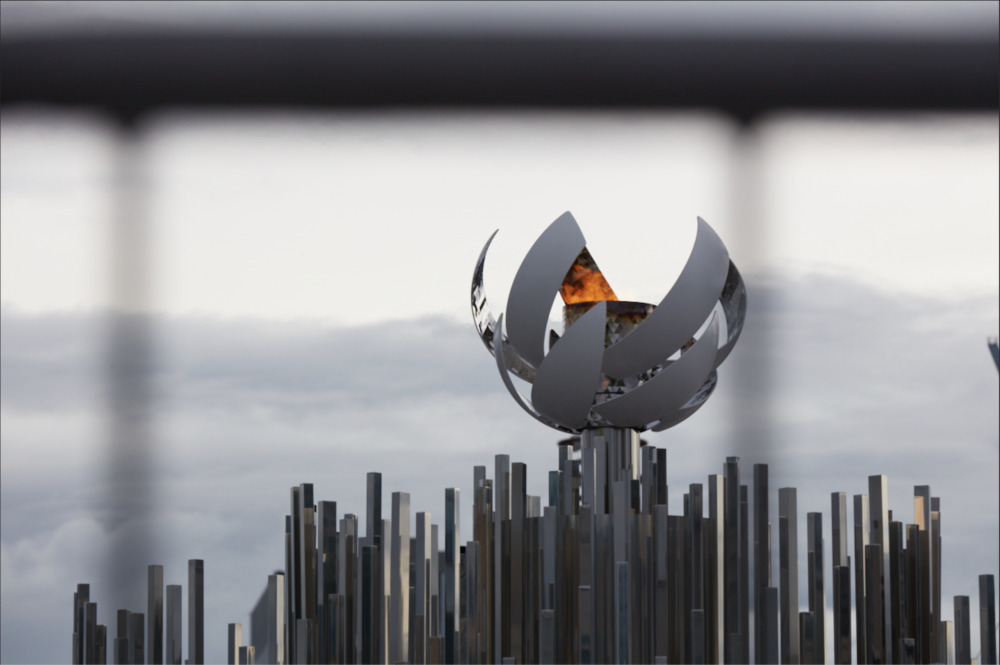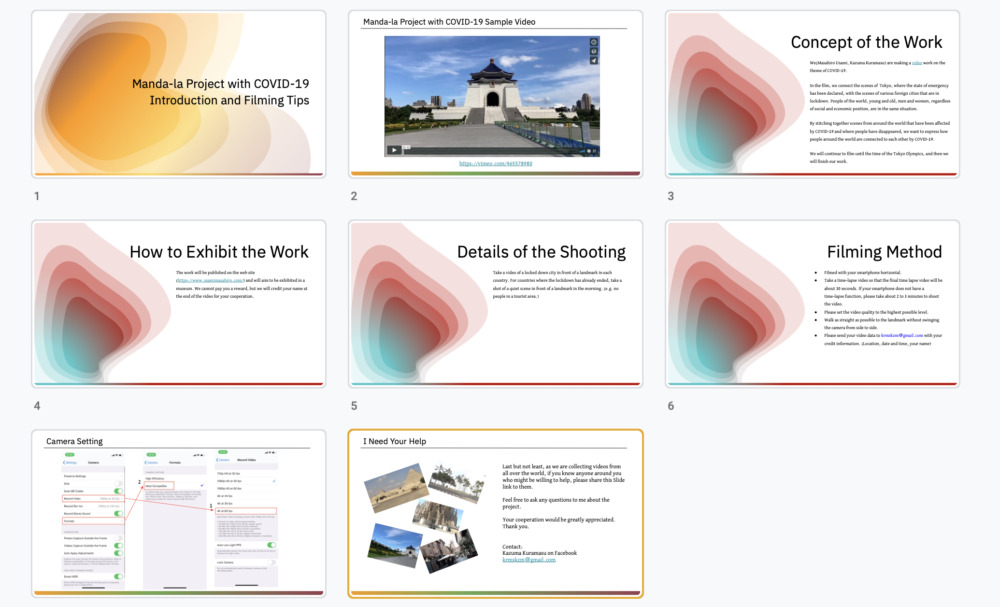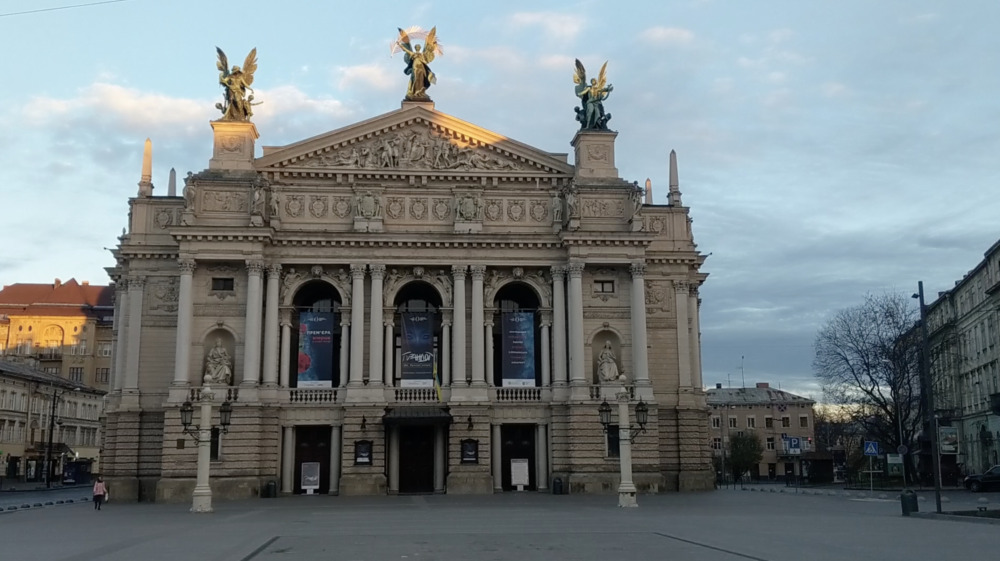Column
ColumnOvercoming the barriers of lockdowns by creating a video with people around the world
We (Masahiro Usami, Kazuma Kuramasu) made a video work on the theme of Covid-19. In the film, we connected scenes of Tokyo, where a state of emergency had been declared, with scenes we asked friends and acquaintances around the world to shoot of various foreign cities that were in lockdown to show how people everywhere, regardless of age, gender, and social or economic position, were in the same situation.
I have been working on the Manda-la Project for a quarter of a century. The title was inspired by the word for geometric configurations of symbols representing the Buddhist universe. The series is made of up photographs with one figure in the center, around which are arranged various people and things that influence them. By containing them all in a single photograph, I condense the subject’s life and their various relationships into a single world, just like a Buddhist mandala. In producing the photographs, I visit the places where the people live numerous times to conduct research and talk to the locals. At first it was a personal project involving people close to me, but the theme and scale gradually grew and changed to the point where it now showcases not only the people in the photographs, but also the history, culture and present state of the places where they live. One of the things I have been particular about from the outset is that I carry out no image-editing. I actually arrange everything that will appear in the photographs in advance and only begin shooting once the stage has been set.
In 2020, I had intended to take photographs on the theme of the Tokyo Olympics as part of this long-running Manda-la project. However, everything was delayed when the world changed completely as a result of the Covid-19 pandemic. Part of the meaning of the word “mandala” is that everything that exists in the world is connected and influences everything else. As it spreads around the world, Covid-19 infects everyone equally regardless of social standing or reputation. This prompted me to come up with the idea of creating a Manda-la video work with Covid-19 at its center.

During a visit to Haneda Airport, quiet due to the fact that all the flights had been cancelled, I shot some video. It was then that I became genuinely interested in making a video work as a means of recording this historic state of affairs. Because we live in an age in which nearly everyone around the world has a smartphone and can shoot video easily, I thought that by joining together videos shot by other people into a single work I might be able to give filmic expression to the pandemic.
I invited the filmmaker Kazuma Kuramasu to join me and together we began filming in Tokyo. I got in touch with the videographer Akio Okamoto who also became involved in the project.

Due to the pandemic, many cities around the world were in lockdown. In these cities, going outside was restricted by law and offenders were subject to penalties. In Tokyo, a state of emergency was declared, but it was not legally binding and people were instead urged to practice self-restraint. The municipal authorities also urged restraint with regard to economic activities. While again this was not legally binding, various stores closed their doors and companies switched to remote work. Perhaps because these measures proved effective, the state of emergency was lifted after around two months, but the peculiar national characteristics of the Japanese reflected in this approach attracted attention from around the world.
What was shocking to me personally was that before the state-of-emergency announcement, when I contacted my mother about traveling from Tokyo where I live to visit the family home in the neighboring prefecture of Chiba, I was told not to come because she was afraid of how the neighbors would react if they saw a car with a Shinagawa license plate from Tokyo, where the number of infected people was high. I could hardly believe that my mother, who was always delighted when her son visited, would say such a thing. In Tokyo, some people acted as if they were the “self-restraint police” and the restrictiveness of a mutual surveillance society became noticeable in the form of such anonymous and self-righteous acts as attacks on social media and critical phone calls directed at stores that remained opened.
The Tokyo I shot during the state of emergency was largely devoid of people and seemed to express one of the national characteristics of the Japanese in that they practice self-restraint, cooperate and for better or worse remain obedient despite the economic risks involved. Following the lifting of the state of emergency, I ventured into the city again. But I realized then that regardless of how early in the morning I went, that scene could never be recreated.
In July 2021, the spectator-less Tokyo Olympics were held, but behind the scenes Covid-19 continued to run rampant.
We continued to shoot video in Tokyo even under these circumstances. And at the same time, without setting foot outside of Tokyo, we collected footage of around 60 cities taken by people around the world showing how streets there looked during the pandemic.
Despite each facing their own difficult circumstances, people cooperated by recording this special moment in time and sending the video to us in Japan. A friend in Hong Kong filmed amid the complex political situation with China. Myanmar descended into civil war. Ukraine has also become a battlefield, and it is currently impossible to ask anyone to film in the squares of Moscow.

Among the friends I contacted was one I had not heard from in decades. The conversation grew lively with past reminiscences as we checked the Covid-19 situation in our respective countries and confirmed we were in similar circumstances. The world had changed since we were last in touch, but Covid-19 existed in it indifferently, mechanically and regardless of people’s wishes like some law of the universe.
By joining together scenes from around the world impacted by Covid-19, it felt as if we had recreated artificially the reality that people all around the world are connected to each other due to the pandemic. We have in common the orbit of the stars and the movement of the nuclei inside of us. All things are composed of some of the same elements. Within these, viruses unconcernedly rush around, multiply and connect the world. Such was the image behind this project. With Covid-19 set to remain with us for some time, we are pushing on while looking for a conclusion.







